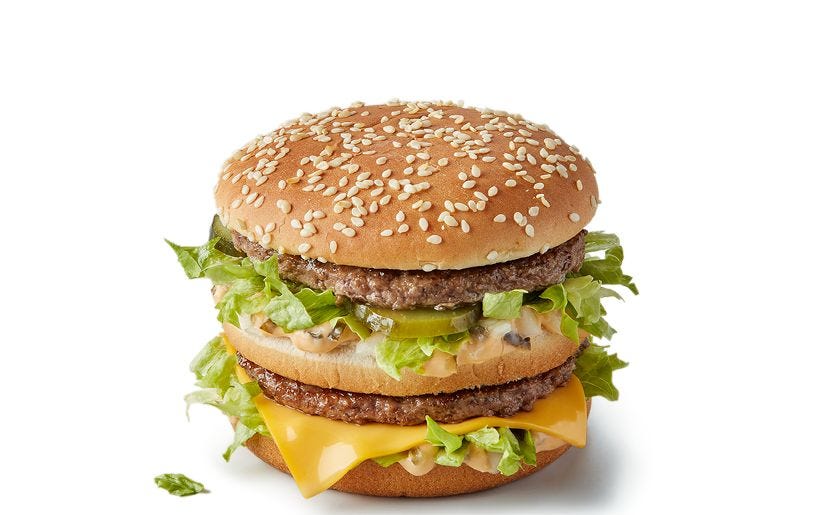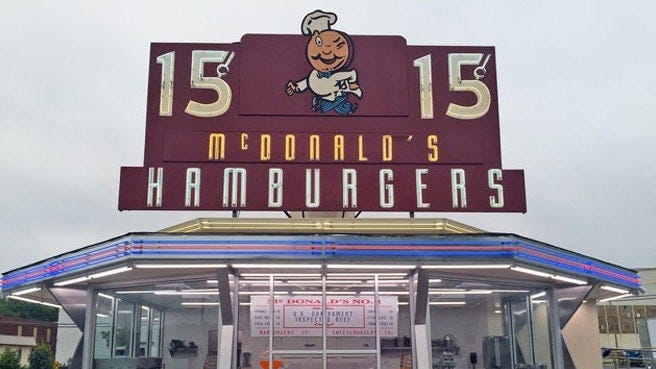Welcome!
Welcome to the Business Scope! This newsletter aims to inform readers about everyday businesses, delving into aspects you may not have considered in depth. As the author, I am obsessed with understanding why companies make certain decisions. Therefore, this series will explore the history and operations of companies worldwide. You will learn about key operational aspects, the company's history, and other intriguing facts you likely haven't considered. As a quick note, I am continuously learning new things as I write, and I hope you will gain newfound knowledge as well. Enjoy!
Introduction
Clearly, to the naked eye, McDonald's is a fast food chain serving hot food at an affordable price. Known for items like the Big Mac and Chicken McNuggets, McDonald's is a prominent figure in the fast food landscape. The intention of this article is not to reiterate these well-known facts, but rather to dive deeper into what makes the company so successful from an operational perspective.
source: McDonalds
A Brief History
The company was founded in 1948 by the McDonald brothers, Dick and Mac, in San Bernardino, CA. Initially venturing into the movie business, the entrepreneurs quickly pivoted to the drive-in restaurant industry after facing failure, where they proved to be successful. Building on this success, they sought to perfect their Speedee Service System, offering consumers the 15-cent hamburger and significantly reduced wait times compared to typical hamburger shops. The brothers soon adopted the franchise model, selling 14 locations, with 10 becoming operational. It was an impressive start, but that was just the beginning.
Dick and Mac are the founders, but anyone deeply interested in business strategy and operations should remember this name: Ray Kroc. Kroc, an entrepreneur at heart, joined the World War One Red Cross Ambulance Corps midway through high school. He then earned money as a musician before moving into sales, starting with paper cups. His journey led him to the Multimixer, the device soon essential for creating McDonald's milkshakes. In 1954, after meeting with Dick and Mac, his association with McDonald's took off. Initially the salesman for an important operational tool, Kroc eventually convinced the brothers to let him become their franchise agent. On Friday, April 15, 1955, Kroc opened his first McDonald's franchise in Des Plaines, Illinois.
Kroc was a visionary, driven to increase profits and expand the chain. This ambition led to friction with the McDonald brothers, who were intensely focused on maintaining high-quality service. Franchising can often boost profits and allow for scaling, but it also risks lowering the quality of locations due to various factors, such as poor hiring practices and a lack of attention to detail. Kroc responded by establishing a subsidiary company separate from the original McDonald's Corp. In 1961, he acquired the rights for $2.7 million. Following this, Ray successfully expanded McDonald's globally, demonstrating the effectiveness of the franchise model at the restaurant level. Today, McDonald's (MCD) is valued at over $200 billion and is listed on the New York Stock Exchange (NYSE).
source: Architectural Digest
The business behind the Golden Arches
Next time you enter a McDonald's, take a moment to appreciate the operational ingenuity behind this successful chain. Start with the golden arches. When you're on the highway searching for something to eat, there's a good chance you'll spot those iconic golden arches mounted on a tall pole. The arches are golden against a red background, a strategic choice. Red is psychologically linked to an increased heart rate, potentially stimulating your appetite. Perhaps you weren't hungry a few minutes ago, but after seeing the McDonald's sign, you might understand the science behind that sudden urge to stop for a bite.
As a publicly traded company with over 36,000 locations worldwide, food safety is paramount to McDonald's success and expansion. In recent years, McDonald's has implemented extensive measures to ensure food safety and quality. To fully grasp this, one must consider their supply chain. McDonald’s works directly with the Global Good Agriculture Program (GLOBALG.A.P.) to ensure farmer safety and provide valuable agricultural education to their farmers. Following the farming stage, the upkeep of supplier facilities is crucial. These facilities must pass regular audits and meet the standards of GLOBALG.A.P., SQMS, and DQMP audit certifications to continue operations. Further down the line, distribution centers and transportation methods are required to have temperature monitoring systems to maintain the freshness and quality of food.
Profit, profit, profit. How does McDonald's generate so much of it? The answer lies in real estate. Yes, McDonald's is essentially in the real estate business. Out of their 30,000+ locations, only 2,100 are directly operated by McDonald's. The rest are run by franchisees. Put simply, franchisees pay rent to McDonald's for their locations, along with fees for using McDonald's equipment, including logo usage and other operational tools. According to the Motley Fool, in 2023, McDonald’s did over $7.3 billion in revenue strictly off of rental income! This number represents roughly 63% of their annual revenue. As it turns out, McDonald's isn’t just a fast-food chain; it's a real estate powerhouse, operating a model that creates opportunities for franchisees while profiting from over 30,000 properties worldwide.
source: fourweekmba
Final Remarks
A company that began with two brothers and a dream to streamline restaurant operations has transformed into a global corporation. McDonald's now thrives on real estate revenue, intelligent marketing, and a strong focus on customer satisfaction. These factors have placed McDonald's at the pinnacle of fast-food establishments. I hope you guys enjoyed this edition of The Business Scope!
Stay tuned for the next volume…
Important Links/Sources:







Spittin facts
Really enjoyed this read, excited for the next one!